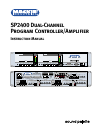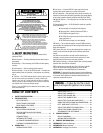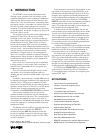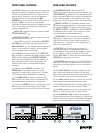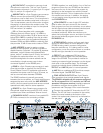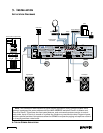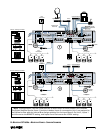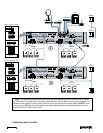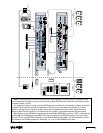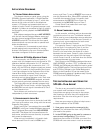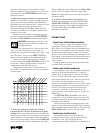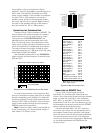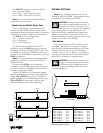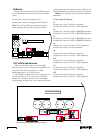
SP2400 – 10
Application Diagrams
A: Typical Stereo Application
This diagram depicts a typical setup, using the
SP2400 in a stereo application. A Digital Satellite
Service (DSS) is connected to Input 1, which also
serves as the music-on-hold for the telephone
system. A CD player and cassette deck are con-
nected to Inputs 2 and 3 for general purpose music
playback. A jukebox is connected to Input 4, which is
configured for priority playback via
AMP ADDRESS
switch #7.
Both sides are assigned the same
AMP ADDRESS
,
with the left channel assigned Master status and
the right channel assigned Slave status via
AMP
ADDRESS
switch #6. This allows the front panel
buttons and both remote controls to operate both
sides simultaneously.
An ambient mic is connected to each side to
provide paging level compensation for varying
ambient noise levels in the room. Both amplifiers
have been configured for 8-ohm operation.
B: Multiple SP2400s: Multiple Zones
In this example, two SP2400s are used in a
system with four separate zones configured for 70V
operation (default configuration for U.S. versions).
Four program sources are connected to Unit 1. Of
these, only the DSS and Jukebox signals are shared
with Unit 2 by means of the Expansion Bus (Inputs
1 and 4 are assigned to the Expansion Bus via the
internal Bus Assign switches). Both units have
sources connected to Inputs 2 and 3 that are
exclusive and not shared between units. Each zone
has a different
AMP ADDRESS
assigned, and each
remote control exclusively operates its own zone.
The Paging Mic can be manually operated with
the Paging Mic Control Switch, and the Paging Mic
and
ALL CALL
control signal is transferred to Unit 2
via the Expansion bus.
Each ambient mic and local mic operates
independently in their own zones.
C: Expansion with Local Mic
This example shows how to share the Local Mic/
Line input with another zone, along with the remote
Expansion Bus signals.
Zone A and Zone C are assigned the same
AMP
ADDRESS
, with Zone A assigned Master status and
Zone C assigned Slave status via
AMP ADDRESS
switch #6. This allows the front panel buttons for
both zones, and all the remote controls, to operate
both zones simultaneously.
When an input is selected, it is heard in both
zones because Zone A is set to
LOCAL
input
source, and Zone C is set to
REMOTE
input source
over the Expansion Bus. When
OFF
is pressed, the
Local Mic connected to Zone A is heard in both
zones because the
PRE OUT
from Zone A is
connected to the
MIC/LINE
input on Zone C.
Zones B and D can select their own input
sources independently.
D: Room Combining—Zones
In this example, a dividing wall can be extended
to divide the room into two. The Mackie Industrial
DX8 is used to route independent source selections
to each zone (Preset 1 on the Remote Controls), or
common input source selections for both zones
(Preset 2 on the Remote Controls).
For example, Preset 1 might route the CD Player
and the Zone A microphone to Zone A, and the
Cassette Player and the Zone B microphone to
Zone B, to be used when the divider is in place
between the two zones. Preset 2 might route both
microphones and the audio signal from the laptop
to both Zones A and B, to be used when the divider
is removed between the two zones.
Both Zones on the SP2400 are assigned the same
AMP ADDRESS, so when “OFF” is selected on the
SP2400, the DX8 signal at the Mic/Line Input is routed
to the SP2400 outputs. The local input sources (Tuner
and CD 5-Disc Changer) or the Global Background
Music via the Expansion I/O can be routed to the
SP2400 outputs by selecting 1 (global remote), 2 (tuner),
or 4 (CD) on the SP2400 front panel.
Tips on Installing and Using the
SP2400—Plan Ahead!
The key to any successful installation is planning
your system well in advance. Know which
components are going to be used in the system,
their locations, and how they will interface with
each other. Plan the wire routing and AC power
requirements.
Here are some steps to follow to help insure a
smooth installation of the SP2400:
1.
How many zones require coverage in the
system?
This will determine how many SP2400s
you need in the system.
2.
Is the SP2400 going to be used in a stereo or
zone (mono) configuration?
This will also
determine the number of SP2400s you need. One
SP2400 will cover two zones in mono or one zone



